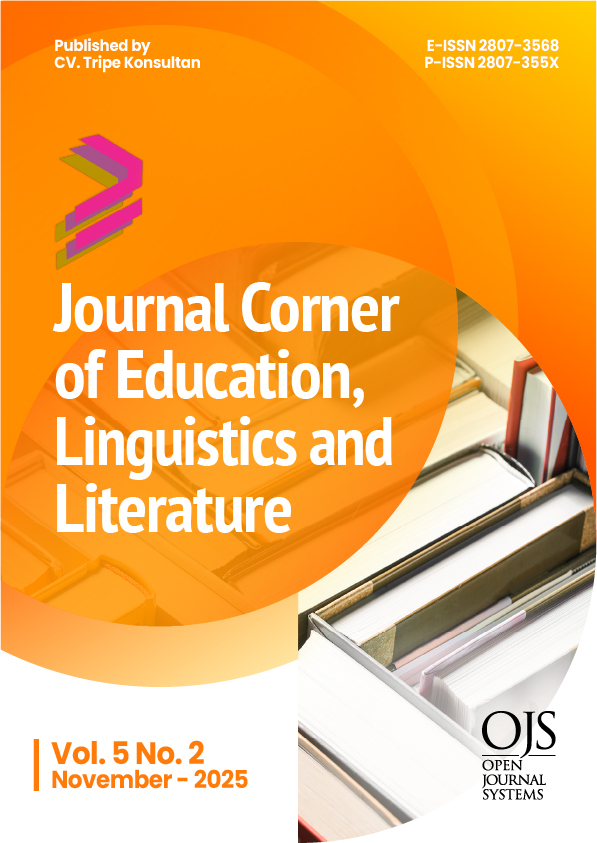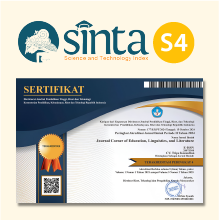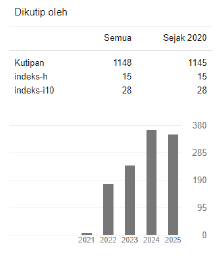Exploring Qualitative Descriptive Methods in Korean Linguistic Studies
 https://doi.org/10.54012/jcell.v5i2.619
https://doi.org/10.54012/jcell.v5i2.619
 Abstract views: 266
Abstract views: 266
 PDF downloads: 188
PDF downloads: 188
Keywords:
Descriptive Qualitative Method, Korean Linguistics, Research Stage, Data Analysis, Mixed-Method ApproachAbstract
The current research aimed to uncover the use of the descriptive qualitative method in Korean linguistic studies, with the main objective of investigating how this method is applied in such research. This study is not merely theoretical but also practical, as it provides guidelines for conducting research in Korean linguistics using descriptive qualitative approaches. The objects of this study were scholarly articles and relevant books, as well as previous research reports selected through purposive sampling, analyzed using a qualitative approach with a library research method and documentation techniques for data collection. The findings reveal six stages in conducting Korean linguistic research with descriptive qualitative methods: problem identification, literature review, determining research objectives, data collection, data analysis and interpretation, and reporting of findings. Furthermore, data analysis involves four essential steps, namely data collection, data reduction, data display, and drawing conclusions. Although the descriptive qualitative method proves beneficial for research in Korean linguistics, it still presents challenges, particularly the potential subjectivity of researchers during data interpretation. Therefore, this research suggests that future studies should be supported by alternative perspectives, such as quantitative methods or a mixed-methods approach that combines both quantitative and qualitative methodologies in linguistic research.
Downloads
References
Adlini, M. N., Dinda, A. H., Yulinda, S., Chotimah, O., & Merliyana, S. J. (2022). Metode Penelitian Kualitatif Studi Pustaka. Edumaspul: Jurnal Pendidikan, 6(1), 974-980. https://doi.org/10.33487/edumaspul.v6i1.3394.
Barrett, D., & Twycross, A. (2018). Data Collection in Qualitative Research. Evidence-Based Nursing, 21(3), 63–64. https://doi.org/10.1136/eb-2018-102939.
Brown, P., & Levinson, S. C. (1987). Politeness: Some Universal in Language Usage. Cambridge University Press. https://www.cambridge.org/af/universitypress/subjects/languages-linguistics/sociolinguistics/politeness-some-universals-language-usage.
Cho, S., & Han, S. S. (2002). Automatic Stemming for Indexing of an Agglutinative Language. In T. Yakhno (Ed.), Lecture Notes in Computer Science (including subseries Lecture Notes in Artificial Intelligence and Lecture Notes in Bioinformatics) vol 2457. Springer. https://doi.org/10.1007/3-540-36077-8_15.
Colorafi, K. J., & Evans, B. (2016). Qualitative Descriptive Methods in Health Science Research. Health Environments Research and Design Journal. https://doi.org/10.1177/1937586715614171.
Creswell, J. W. (2014). Research Design: Qualitative, Quantitative, and Mixed Methods Approaches (4th ed.). SAGE Publications. https://books.google.co.kr/books/about/Research_Design.html?id=4uB76IC_pOQC&redir_esc=y.
Creswell, J. W., & Guetterman, T. C. (2019). Educational Research: Planning, Conducting, and Evaluating Quantitative and Qualitative Research. Pearson. https://books.google.co.kr/books/about/Educational_Research.html?id=s7rNtAEACAAJ&redir_esc=y.
Creswell, J. W., & Poth, C. N. (2017). Qualitative Inquiry and Research Design: Choosing Among Five Approaches (4th ed.). SAGE Publications. https://books.google.co.kr/books/about/Qualitative_Inquiry_and_Research_Design.html?hl=id&id=gX1ZDwAAQBAJ&redir_esc=y.
Daliman, A. (2012). Metode Penelitian Sejarah. Penerbit Ombak. https://books.google.co.kr/books/about/Metode_penelitian_sejarah.html?id=wvsWnQAACAAJ&redir_esc=y.
Darmanto, D., Cahyo, E. N., Nengrum, Y. S., & Adefiannisa, F. J. (2025). Linguistic Diplomacy: The Role of Korean Language in Indonesia–South Korea Relations. Jurnal Multidisipliner Bharasumba, 4(3), 401–419. https://doi.org/10.62668/bharasumba.v4i03.1682.
Darmanto, D., Dewi, E. Z. P., Muliawan, A. A., Hakim, L., Kristanto, N., Wulandari, R., Setiawan, D., Pradana, M. A. R., & Nengrum, Y. S. (2025). Promoting Employment Opportunities in South Korea at SMK Telekomunikasi Brawijaya Blitar. Jurnal Pengabdian Masyarakat Sabangka, 4(4), 444–454. https://doi.org/10.62668/sabangka.v4i04.1674.
Doyle, L., McCabe, C., Keogh, B., Brady, A., & McCann, M. (2020). An Overview of The Qualitative Descriptive Design within Nursing Research. Journal of Research in Nursing, 25(5), 443–455. https://doi.org/10.1177/1744987119880234.
Fadli, M. R. (2021). Memahami Desain Metode Penelitian Kualitatif. Humanika: Kajian Ilmiah Mata Kuliah Umum, 21(1), 33–54. https://doi.org/10.21831/hum.v21i1.38075.
Fraenkel, J. R., Wallen, N. E., & Hyun, H. H. (2012). How to Design and Evaluate Research in Education (8th ed.). McGraw-Hill Higher Education. https://books.google.co.kr/books/about/How_to_Design_and_Evaluate_Research_in_E.html?id=21w3YgEACAAJ&redir_esc=y.
Indrawan, D., Pandin, M. G. R., Armando, M., Afandi, M. R., & Putri, M. P. (2022). The Influence of Korean Drama towards The Behavior and Grammar of Generation Z in Indonesia. OSF Preprints, 1(10). https://osf.io/preprints/osf/275a9_v1.
Jang, W., & Song, J. E. (2017). Webtoon as a New Korean Wave in the Process of Glocalization. Kritika Kultura, 29, 168–187. https://doi.org/10.13185/KK2017.02908.
Kim, H., Sefcik, J. S., & Bradway, C. (2017). Characteristics of Qualitative Descriptive Studies: A Systematic Review. Research in Nursing & Health, 40(1), 23–42. https://doi.org/10.1002/nur.21768.
Krueger, R. A. (2014). Focus Groups: A Practical Guide for Applied Research. SAGE Publications. https://books.google.co.kr/books/about/Focus_Groups.html?id=APtDBAAAQBAJ&redir_esc=y.
Martin, P. Y., & Turner, B. A. (1986). Grounded Theory and Organizational Research. The Journal of Applied Behavioral Science, 22(2), 141–157. https://doi.org/10.1177/002188638602200207.
Maulidita, S. Z., & Darmanto, D. (2024). Indonesia’s Opportunities and Challenges in IK-CEPA: Bilateral Free Trade Agreement with South Korea. Insignia: Journal of International Relations, 11(1), 19–35. https://doi.org/10.20884/1.ins.2024.11.1.9926.
Miles, M. B., & Huberman, A. M. (1994). Qualitative Data Analysis: An Expanded Sourcebook (2nd ed.). Sage Publications. https://books.google.co.kr/books/about/Qualitative_data_analysis.html?id=U4lU_-wJ5QEC&redir_esc=y.
Muliawan, A. A., Darmanto, D., Hakim, L., Dewi, E. Z. P., & Cahyo, E. N. (2025). Signs Beyond: A Semiotic Reading of Transcendence in “Stuck in the Middle” by Babymonster. Jurnal Multidisipliner Bharasumba, 4(3), 303–323. https://doi.org/10.62668/bharasumba.v4i03.1673.
Putri, I. P., Liany, F. D. P., & Nuraeni, R. (2019). K-Drama dan Penyebaran Korean Wave di Indonesia. ProTVF, 3(1), 68–80. https://doi.org/10.24198/ptvf.v3i1.20940.
Raco, J. R. (2010). Metode Penelitian Kualitatif. Grasindo. https://books.google.co.kr/books/about/Metode_Penelitian_Kualitatif.html?id=jOByDwAAQBAJ&redir_esc=y.
Rostineu, R. (2021). The Sociocultural Factors Influencing the Study of Korean History in Indonesia. International Journal of Korean Humanities and Social Sciences, 7, 163–177. https://doi.org/10.14746/kr.2021.07.08.
Sandelowski, M. (2000). Whatever Happened to Qualitative Description? Research in Nursing & Health, 23(4), 334–340. https://doi.org/10.1002/1098-240x(200008)23:4<334::aid-nur9>3.0.co;2-g.
Seixas, B. V., Smith, N., & Mitton, C. (2018). The Qualitative Descriptive Approach in International Comparative Studies: Using Online Qualitative Surveys. International Journal of Health Policy and Management, 7(9), 778–781. https://doi.org/10.15171/ijhpm.2017.142.
Silverman, D. (2004). Qualitative Research: Theory, Method and Practice. In Qualitative Research. SAGE Publications. https://books.google.co.kr/books/about/Qualitative_Research.html?id=-YvRs1O87KkC&redir_esc=y#:~:text=It succeeds in providing a comprehensive yet accessible,discuss the theory and practice of qualitative research..
Sohn, H. M. (2001). The Korean Language. Cambridge University Press. https://books.google.co.kr/books/about/The_Korean_Language.html?id=Sx6gdJIOcoQC&redir_esc=y.
Sugiarto, E. (2015). Menyusun Proposal Penelitian Kualitatif Skripsi dan Tesis. Suaka Media. https://openlibrary.telkomuniversity.ac.id/pustaka/101258/menyusun-proposal-penelitian-kualitatif-skripsi-dan-tesis.html.
Sugiyono, S. (2013). Metode Penelitian Pendidikan Pendekatan Kuantitatif, Kualitatif dan R&D. Alfabeta. https://digilib.unigres.ac.id/index.php?p=show_detail&id=43.
Walidin, W., Saifullah, S., & Tabrani, T. (2015). Metodologi Penelitian Kualitatif & Grounded Theory. FTK Ar-Raniry Press. https://repository.ar-raniry.ac.id/id/eprint/1301/.
Yeon, J., & Brown, L. (2019). Korean: A Comprehensive Grammar. In Korean: A Comprehensive Grammar. https://doi.org/10.4324/9781315160351.
Zed, M. (2008). Metode Penelitian Kepustakaan. Yayasan Pustaka Obor Indonesia. https://books.google.co.kr/books/about/Metode_Penelitian_Kepustakaan.html?id=zG9sDAAAQBAJ&redir_esc=y.
Downloads
Published
How to Cite
Issue
Section
License
Copyright (c) 2025 Eko Nur Cahyo, Darmanto Darmanto, Anugrah Adi Muliawan, Salismi Zulfi Maulidita, Siti Masruroh

This work is licensed under a Creative Commons Attribution-ShareAlike 4.0 International License.
All articles published in the Journal Corner of Education, Linguistics, and Literature are licensed under the Creative Commons Attribution-ShareAlike License (CC BY-SA).

















